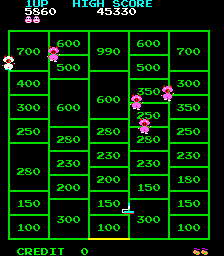 Memories
are weird. Right?
Memories
are weird. Right?
The stuff you remember, I mean. F’rinstance, some people can’t remember their friends’ birthdays or their eye color, but nearly everyone remembers what they were doing when they heard that the Space Shuttle exploded. Weird.
I think the whole memory thing applies to the great video games we’ve all played over the years too. Don’t you? You don’t? Are you sure? Don’t you remember where you were the first time you played Ms. Pac-Man or Dragon’s Lair, or Mortal Kombat II? I sure do.
I also remember the first time I played Amidar. It was at, of all places, the grocery store.
The local grocery store was one of those “super-advanced-humongous” grocery stores that was way ahead of its time. It had all the regular stuff, bakery, deli, fresh produce, etc., but it also had a fabric department (?), video game carts, and… a strip of arcade games.
Us kids found the arcade games right away, but we usually didn’t get to play any because our pockets were empty. On one trip to the store, I found a discarded “Royals” wrapper lying on the floor next to the base of the change machine. Remember “Royals”? They were actually thinly disguised, minty-fresh M&Ms. Instead of coming in the popular array of colors, they only came in dark brown and mint green. The white “M”s were replaced by a little crown icon, and the chocolate center was replaced by either mint or minty chocolate, I can’t remember. Royals really weren’t very good, and they quickly disappeared from the marketplace. Poof!
Anyhoo, I don’t know what possessed me to do what I did next, but… I took the Royals wrapper and stuck it into the change machine. As I was turning to walk away… ting, ting, ting, ting! Out came four shiny quarters.
And with that innocent act of petty larceny, I deposited a quarter into Amidar.
If you’re only familiar with Amidar because you had sadomasochistic family members who gave you the horrible Parker Brothers version for your Atari 2600 as a “gift,” then it’s a good bet you aren’t too fond of the game. That’s a crying shame, since the original arcade title is a far cry from the vastly inferior VCS turd. Imagine taking the Amidar arcade game, cramming it in a blender and hitting “puree.” Now stick in one of those ice-cream soda straws. Now suck ALL of the fun out of the mix. What’s left is the Parker Brothers version for the 2600.
The 2600 version fails on all accounts. The graphics are awful (and flicker like you wouldn’t believe), the sound (what little sound there is) is awful, and the game play is truly horrifying. If you thought 2600 Pac-Man was a miserable use of an arcade license, imagine playing it after someone turned the speed dial all the way down to zero. Ugh.
The real-deal Amidar is a fast-paced, fun little game where you play as a mighty ape during the odd numbered rounds, and a nifty paint roller on the even numbered rounds. Each level is a grid that must be traversed in order to fill in all the rectangles – if you’ve played Pepper II, you get the idea. Once the entire board is filled in, you move on to the next round. The ape rounds feature your garden-variety video game dots while the paint roller rounds are dotless. The only real play-mechanic difference between the two stages is that on the paint roller stage, you can’t stray too far from the line/box you’re currently painting or you’ll run out of paint. At that point, you can run over all the lines you want, but they won’t get painted. You’ll have to go back to the last filled in box and pick up the trail again.
During all of the rounds, you’re chased by several “Amidars” (between 4 and 6, depending upon how far into the game you are) and one “Tracer.” Amidars move by turning at every intersection while the Tracer merely traces the outer perimeter of the board. If
you spend too much time on a level, the Tracer stops tracing the perimeter and begins tracing your movement. Both the Amidars and Tracers kill on contact, but you do have the ability to force them to jump, giving you the chance to hurry past them. Use the jumps sparingly - you only get three jumps per round / life, whichever comes first.
In either of the scenarios, filling in the four corner rectangles will temporarily empower the ape / paint roller so that the player may hunt the Amidars. Eliminating them (temporarily) is where most of the points are gang, so take note: once you learn the movements of the Amidars, you’re well on your way to a high score of DP proportions!
Each time a round is cleared, the player gets an opportunity to grab a bunch of bananas for bonus points. A new grid appears with a pig at the top. The pig quickly moves past six paths as the player decides which one to stop the pig at by pressing the jump button. Pressing jump sends the pig down the desired path, and if the player is particularly sharp (or just really lucky) the pig grabs the bananas at the end. Why the design team opted to have a pig grab a bunch of bananas instead of the ape is beyond me, but…
That doesn’t stop Amidar from being a top-notch fill-in-the-maze maze-game. The music is terrifically whimsical, and the sparse sound effects are right on the monkey. Er, money. Royals candy may have come and gone quickly, but Konami’s Amidar is a classic that’s destined to stick around for a long, long time. Like a screeching monkey caught in a Buick-sized wad of chewing gum. And if you really miss those Royals, you can always substitute a box of Junior Mints. Bleah. Gimme some mint-free M&Ms any day.
